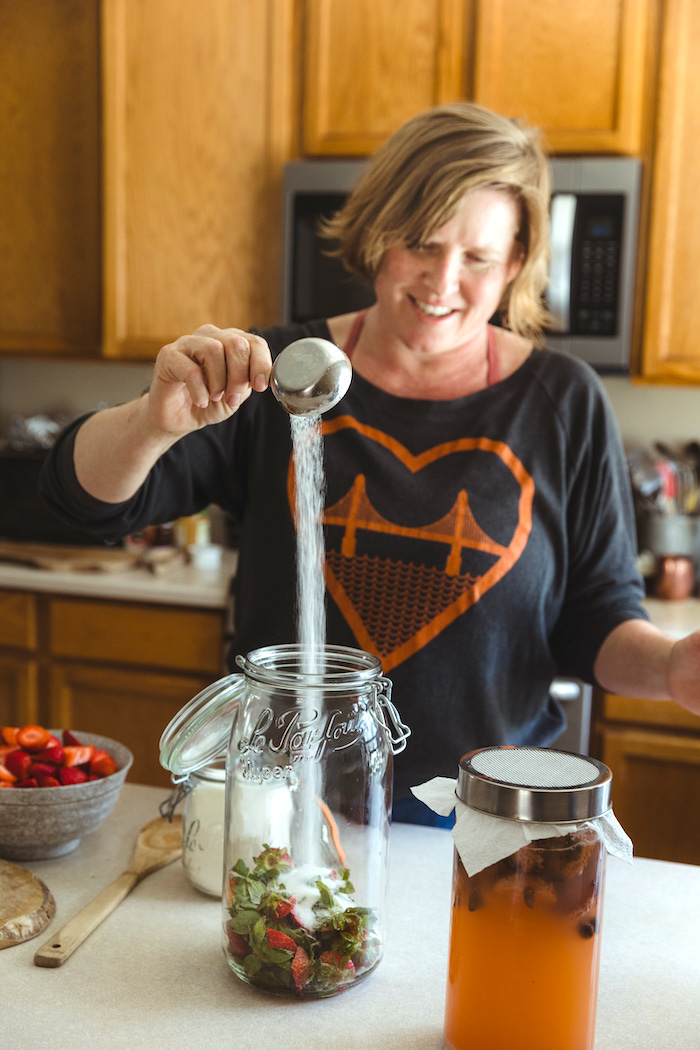 I’ll be honest. When I see a kid take one bite of a juicy red strawberry, then chuck the rest, I want to google their value in Bitcoin and sell to the highest bidder. I go mad thinking of all the hours the farmer had her hands in the dirt, all the water that nurtured the soil to make it grow, the trucks that carried it, the labor of my grocer, MY labor. OY. So I guess you could say I’m a germophile AND a waste-phobe.
I’ll be honest. When I see a kid take one bite of a juicy red strawberry, then chuck the rest, I want to google their value in Bitcoin and sell to the highest bidder. I go mad thinking of all the hours the farmer had her hands in the dirt, all the water that nurtured the soil to make it grow, the trucks that carried it, the labor of my grocer, MY labor. OY. So I guess you could say I’m a germophile AND a waste-phobe.
And what do you get when you cross a germophile, a waste-phobe and strawberry season? A gorgeous pink vinegar made of strawberry scraps that is not only probiotic, but low waste and doesn’t make you growl at children. This vinegar could adorn your strawberry, beet and goat cheese salad, or make a cold-pressed pink shrub to muddle with mint for a hot spring afternoon. And the best part is, it’s loaded with beneficial bacteria for your bod.
I first heard of fruit scrap vinegar a few years ago when a friend told me he saved up his old apple cores and pear parts in the freezer until he had enough for a good batch of homemade vinegar. But the making of this sour concoction is just as old as the making of alcohol. The first evidence dates from around 3,000 BC, when the Babylonians used dates and figs to make vinegar. It’s been in our lives as food, medicine, and cleaning agent ever since.
Medicinally, vinegar is touted as a cure-all. Said to improve everything from tummy troubles to sunburn, a systematic meta-review in 2020 found that consuming vinegar can even be beneficial in lowering blood sugar in patients with diabetes. It also works wonders on the skin, helping maintain our natural pH balance. I use raw apple cider vinegar with chamomile tea as a toner for my face.
You can really make fruit scrap vinegar out of anything: berries, pineapple, coconut, raisins, kiwi, even dried or frozen fruit. As long as the fruit is organic, all its good bacteria should be intact enough to get you started. Just be sure you cut the tops off the berries before anyone bites into them, to avoid contamination from unwanted bacteria. Good raw vinegar should have a cloudy swirl at the bottom, called “the mother,” which has all the bacteria love you are looking for.
The process is incredibly easy, and like Michael Pollan says of bread– it takes a lot of time, but thankfully not your time. Ten minutes of labor and six weeks of peeking into your cupboard yields a probiotic pink marvel that could be your healing elixir for a sore throat or your signature summer switchel with molasses and lemon. So the next time a little four-foot boogie-eater starts reaching for your flat of strawberries, tell ’em to hold off til you’ve cut those tops off.
MATERIALS
glass jar or crock
coffee filter, paper towel, or clean dish towel
rubber band
INGREDIENTS
2-4 cups organic strawberry tops/scraps
½ cup sugar, divided 1 quart filtered water
1 teaspoon raw apple cider vinegar with the mother (the cloudy swirl at the bottom of your vinegar)
DAY 1
Place cut strawberry tops in jar and add ¼ cup of sugar and all the water
Stir until sugar is dissolved
DAY 2
Add remaining ¼ cup of sugar and stir until dissolved
Cover with coffee filter, paper towel or dish towel and rubber band to secure
Leave in cool dark place
DAYS 3- 45
Stir vinegar once a day
After about a week it will get foamy and bubbly and smell alcoholic–this is normal
After a month, strain out fruit solids, and add the apple cider vinegar
Leave in a cool dark place undisturbed for another two weeks or until the acidity is to your liking, then transfer to your fridge
Use in sweet and savory dressings and drinks
Photos: Tammy Horton

